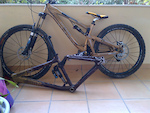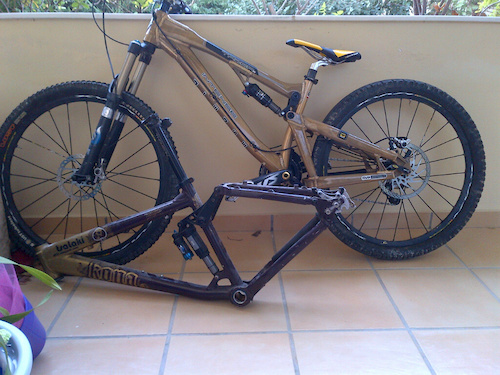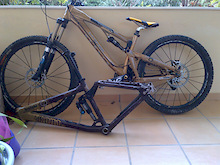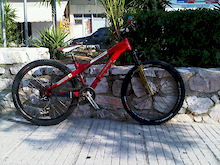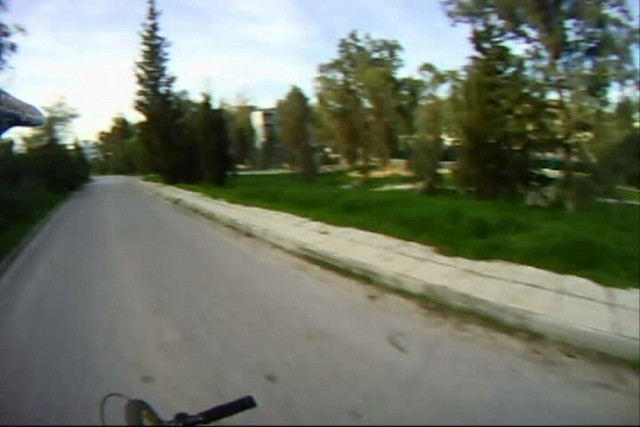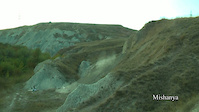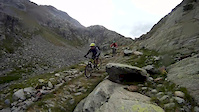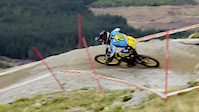kritonh
- Member since Oct 26, 2008
- Male / 55
-
 Athens , Greece
Athens , Greece - 1 Followers
- 0 Trailforks Points
Recent

kritonh RichardCunningham's article
Apr 21, 2013 at 12:50
Apr 21, 2013
Pivot Firebird 275 - 160 Millimeter All-Mountain Shredder
Respect to manufacturers who still produce 100mm 4x bikes especially like this one and Tazer VP with efficient pedaling designs, be it VPP or DW. Very nice geometry on the firebird too and I would ask for the DHX air option on the frameset.

kritonh RichardCunningham's article
Oct 17, 2012 at 13:41
Oct 17, 2012
Cane Creek - Ask Us Anything
Dear Cane Creek,
Congratulations for your excellent products. Excuse me for bringing linearity, progression and choosing between the air and coil once again, but what would help me choose would be the following.
On a bike with an 8.5 by 2.5 stroke shock with a 400lb/in coil I use 2mm of preload and 30% sag which yields aprox 320lb force, and I am assuming negligible internal and linkage friction. At 60% suspension depression the coil force will be 600lbs. At t full travel it will be 1000lbs.
At rest the force for both coil and air will be the same. So my question is at 65% and 100% travel , is the force of the air spring lower or higher and by what percentage accordingly. A link to a graph would be most helpful.
Thanks and Regards.

kritonh RichardCunningham's article
May 22, 2012 at 4:03
May 22, 2012
Tech Tuesday - What a Negative Spring is and Why it Makes the Coil-Spring Nearly Obsolete
3 years back I tested a DHX air on a specialized Big hit, the older model. It absolutely minimized pedal bobbing, behaved actually quite well in jumps and drops but this frame had a rising rate suspension making it very progressive, but on a rocky trail or rock garden you thought you had 5-6 inches of travel and the tires not glued to the ground like the cheaper van rc coil shock.
A SC nomad in a German magazine was test winner with a coil shock in one year and almost last with an air shock a year later, had the not been a sigle pivot bike with an air shock.
So I d think that an air shock is preferable for trail bikes up to 100mm travel, like the bike on the second part of the video. An air shock could possibly be acceptable by a world champion in a particular track, but on an all mountain bike, the joy, quality, smoothness of operation of the suspension with a coil shock and tunability with different spring rates and preload , can help tune any bike with any leverage type to the requirements of its rider.

kritonh RichardCunningham's article
May 22, 2012 at 4:03
May 22, 2012
Tech Tuesday - What a Negative Spring is and Why it Makes the Coil-Spring Nearly Obsolete
B. Personal testing.
I have a Tracer 2 on which I changed the rp23 to RC4. The bike was a joy to ride but with the rc4 it can do everything. You could go to maximum sag with the pr23 and for example go relatively comfortably on a rocky trail but then forget any drop more than 4-5 ft. One could argue using a DHX air with bottom out compression but this shock has even less mid stroke support.( the ratio we talked before)
Going to the lesser sag ( within allowance) , meaning higher pressure on the rp 23 led to stiff bike feeling it has less travel. For example I ride a Tazer vp with minimal sag and on drops the two bikes did not feel far apart.
The tracer with the rc4 is simply amazing. You can blast trough any trail or dh track which indeed is not what it is supposed for, with comfort and surefooting.
Indeed the rc4 is heavier, but one can also bump up the pressure in the rear tire which reduces its friction and makes for a faster bike balancing some of the weight handicap.

kritonh RichardCunningham's article
May 22, 2012 at 4:02
May 22, 2012
Tech Tuesday - What a Negative Spring is and Why it Makes the Coil-Spring Nearly Obsolete
Excellent topic, very informative and good video. However allow me to offer my different perspective which is that air shocks more than air forks are way behind coil shocks from A. a design and construction perspective and B. by personal testing.
A. Compared to the lower pressures required for a fork the high pressures of a shock require much tighter seals and higher friction on the shaft and the protruding stanction. One can argue about the Kashima or special oils with friction additives like I ve used in air Totems with success. I ve tested an Intense tracer with Kashima shock and one without and could not notice a difference either when pedaling or on the trail. On a 36 fork I think I could, but also note that the non kashima was well prepared for a ride.
Negative and Positive piston area ratio create a slope of the force as the shock compresses and it would be nice for the manufacturers to post that as well the spring rate so we can choose accordingly.
So what existed before the negative chamber? was there vacuum or was there a rubber bump or just a hole?
Unless you try a bike and continuously bunny hop and feel the extension of the suspension , on the trail you are always somewhat compressed and the feel there is what is more important, not how it feels when you drop the bike in a LBS.
Agreed that the weight difference for a trail bike is considerable with a steel spring.
Regarding tunability, the negative pressure is dependent on the positive pressure so back to the fixed ratio. Scott with their equaliser shock had separate adjustment for positive and negative pressures as does the new Cannondale. Read some reviews about them and the riders comments about small bump compliance. Forks generally have pos and neg adjustments so are more tunable.

kritonh JulianCoffey's article
May 2, 2012 at 2:51
May 2, 2012
Beyond The Jump: Paul Bas Q&A
Me too as I broke my Bass... Paul is great!

